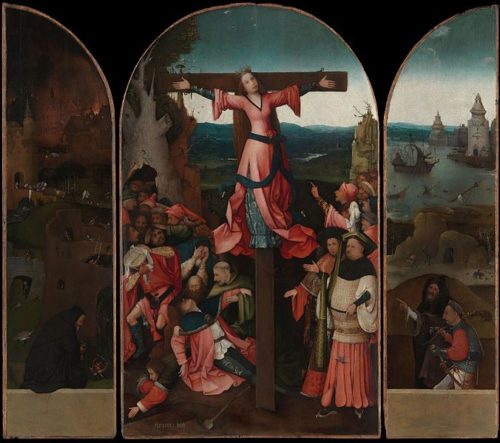Last Updated on July 21, 2024 by Kittredge Cherry
Saint Wilgefortis prayed to avoid marriage to a pagan king — and her prayers were answered when she grew a beard! This “virgin martyr” virgin martyr has natural appeal for LGBTQ people. Her feast day is July 20.
She was removed from the official Vatican calendar in 1969, but Wilgefortis remains in standard Catholic reference works. Images of her as a bearded woman on a cross are plentiful across Europe and in Latin American folk retablos.
She probably originates more in popular imagination than in history, but Wilgefortis continues to be an object of devotion in folk religion, a favorite character in pop culture and an inspiration in queer art, music and literature. Wilgefortis belongs to a group of transgender or cross-dressing saints with similar stories. All were raised as girls and then joined monasteries where they lived as monks. Their female upbringing and anatomy were not discovered until they died. Wilgefortis is the most popular of these gender-expansive saints at Q Spirit, followed by Marina / Marinos the Monk.
Contemporary readers have come up with many theories about Wilgefortis. She has been interpreted as the patron saint of intersex people, an asexual person, a transgender person, a person with Polycystic Ovary Syndrome or a lesbian virgin.
Legend says that Wilgefortis was the teenage Christian daughter of a king in medieval Portugal. She had taken a vow of chastity, but her father ordered her to marry a pagan king. She resisted the unwelcome marriage by praying to be made repulsive to her fiancé. God answered her prayers when she grew a beard.
Unfortunately her father got so angry that he had her crucified and Wilgefortis joined the ranks of virgin martyrs. The church has promoted “virgin martyrs” as examples of chastity and faith, but lesbians and other queer people recognize them as kindred spirits who do not engage in heterosexual activity.
Her veneration began in 14th century Europe and grew until the 16th century, when her story was debunked as fiction. People continued to worship her despite frequent opposition by church officials. She was honored all across Europe, and in some places her popularity rivaled the Virgin Mary. Scholars suggest that her legend arose to explain the Volto Santo (Holy Face) of Lucca, a famous Italian sculpture of the crucified Christ in a long tunic that medieval viewers thought was a woman’s dress.
The history is explored in the book “The Female Crucifix: Images of St. Wilgefortis Since the Middle Ages” by Ilse E. Friesen, professor of art history at Wilfrid Laurier University in Canada. The author traces the emergence of increasingly female crucifixes over the centuries, focusing on the he German-speaking regions of Bavaria and Tyrol, where the veneration of Wilgefortis reached its peak.

Saint Wilgefortis appears on the cover of “The Bloomsbury Reader in Religion, Sexuality and Gender”
Saint Wilgefortis appears on the cover of the 2017 book “The Bloomsbury Reader in Religion, Sexuality and Gender,” edited by Donald Boisvert and Carly Daniel-Hughes (editors). The introduction explains:
Wilgefortis adorns the cover of this reader because her story offers a compelling example of how religion and sexuality intersect. It reveals, first, how sexuality regularly infuses religious devotion and identification…. But there is something more here that solicits our interest in this saint’s story. For it indicates that holiness or sacredness may itself be “queer.” Here we take queer not as an identity (something that Wilgefortis has), but rather as a description of how her story unsettles normative binaries, such as male/female and human/divine.
The name Wilgefortis may come from the Latin “virgo fortis” (strong virgin) or the Old German “heilige Vartez” (holy face). In Spanish she is Liberada — meaning “liberated,” set free from hardship and/or husbands. She also goes by a bewildering variety of other names. Her alternate English name Uncumber means escaper. In addition, she is known as Liberata, Liberadamm Liverade, Kummernis, Komina, Beauvais, Comera, Cumerana, Debarras, Ulfe, Ohnkummer, Ontcommen, Ontcommere, Dignefortis, Europia, and Reginfledis. In Barcelona (Spain), local people honor Múnia de Barcelona, a legendary saint who is similar to Wilgefortis. Her feast day day is Feb. 28.
The saint appears “like Jesus in drag” and speaks for herself in singer-songwriter-pianist Rebecca Clamp’s song, “St. Wilgefortis.” Clamp is originally from Cambridge, England, and moved to Helsinki, Finland. She engages in a sweetly quirky dialogue with the saint in a song and concludes:
I won’t marry a heathen
And I won’t marry a saint
I won’t marry at all
Just grow me a beard
And find me a cave
I’ll be a happy little hermit
And I’ll build a little shrine
To my dear St. Wilgefortis
Oh ridiculous
To my dear St. Wilgefortis
The patron saint of bearded ladies
To my dear St. Wilgefortis
So sublime, so sublime
Wilgefortis in art
Wilgefortis has fascinated artists from historical times up to the present. The saint is presented in two incarnations — as Wilgefortis and as Liberata — in the “Queer Santas” series by contemporary Chicana artist Alma Lopez. The series grew out of the artist’s insight that female martyrs may have protected their virginity to the death not so much out of faith, but because they were lesbians. Lopez paints Wilgefortis/Liberata as masculine women in crucifixion poses. They look like butch lesbians, liberating themselves by rejecting feminine appearance and traditional gender roles. Lopez is best known for her controversial images of Our Lady of Guadalupe.
Dutch Early Renaissance painter Hieronymus Bosch is one of the historical artists who painted the saint. His 1497 triptych is sometimes identified as the Martyrdom of St. Wilgefortis or Liberata, and sometimes as the Crucifixion of St. Julia. It is located at the Palazzo Ducale in Venice, Italy.

“The Martyrdom of St Wilgefortis” by Hieronymus Bosch (Wikipedia)
Wilgefortis also makes various appearances in modern literature. The critically acclaimed 1970 novel “Fifth Business” by Robertson Davies concerns a scholar researching Wilgefortis. Castle Waiting, a graphic novel by Linda Medley, features a nun from the order of St. Wilgefortis, an entire convent full of bearded women!
There’s a wonderful part in the comic Castle Waiting with a coven of bearded nuns fully committed to her as their patron saint ❤️❤️❤️ pic.twitter.com/jzBH4r86Vd
— Stef Gaines 🐈 (@StefGaines) December 4, 2018
Links related to Wilgefortis
“Wilgefortis, patron saint for the LGBTQ+ community” by Emma Cieslik (USCatholic.org, June 24, 2024)
“Saint Wilgefortis: A Queer Image for Today” by Stephanie Budwey (Religions journal, July 2022)
Uncumber or Wilgefortis (Queering the Church)
Wilgefortis Comes To Brisbane (Holy Irritant blog)
Oração ao Cristo Arco-íris (Rainbow Christ Prayer in Portuguese): A bandeira LGBT revela um Cristo diferente
To read this post in Spanish / en español, go to Santos Queer:
Santa Liberada (Wilgefortis): Una santa Barbuda
___
Top image credit:
Saint Wilgefortis statue in the Church of Saint Nicholas in Pas-de-Calais, near Wissant, France (Wikimedia Commons)
___
This post is part of the LGBTQ Saints series by Kittredge Cherry. Traditional and alternative saints, people in the Bible, LGBTQ martyrs, authors, theologians, religious leaders, artists, deities and other figures of special interest to lesbian, gay, bisexual and transgender and queer (LGBTQ) people and our allies are covered.
This article was originally published in July 2017, was expanded with new material over time, and was most recently updated on July 20, 2024.
Copyright © Kittredge Cherry. All rights reserved.
Qspirit.net presents the Jesus in Love Blog on LGBTQ spirituality.

.jpg)










I saw St wilgefortis on a mediëval little church at Burton park house Sussex church dedicated to St Richards. But St Wilgefortis is painted on a cross upside down. What is the meaning of this? She has long golden hair but no beard. Can anyone enlight?
I did some searches and was able to find an account by therapist Anthony Ryle, who visited that same church in Sussex. After studying the Wilgefortis crucifix there, he wrote that the upside-down crucifixion “apparently enjoyed a brief vogue.” You can read his full account at:
https://www.acat.me.uk/reformulation.php?issue_id=3&article_id=38
the Galeria Accademia in Venezia has a Bosch triptych of the “Crucufixion of Santa Liberata”
It’s a nice surprise to find out that Hieronymus Bosch painted Saint Wilgefortis / Liberata! I looked it up and discovered that the painting was previously misidentified as Saint Julia. I plan to add a reference to this triptych in my main article. Thanks for the tip!
For now, people can see it online at this link:
https://www.wga.hu/html_m/b/bosch/6venice/st_julia.html
Another fascinating article. Thank you! I remember Saint Wilgefortis from Davies Deptford Trilogy novels. Hadn’t realised she was an actual saint!